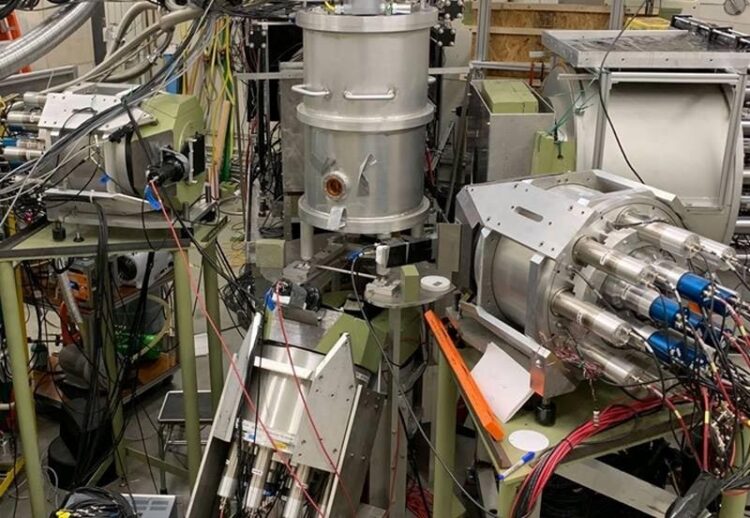How stiff is the proton?

Compton scattering setup at the High Intensity Gamma Ray Source. The central cylinder is the liquid hydrogen target. High energy gamma rays are scattered from the liquid hydrogen into eight large detectors that measure the gamma rays’ energy.
Image courtesy of Mohammad Ahmed, North Carolina Central University and Triangle Universities Nuclear Laboratory
Scientists measure the proton’s electric and magnetic polarizabilities using the High Intensity Gamma Ray Source (HIGS).
The Science
The proton is a composite particle made up of fundamental building blocks of quarks and gluons. These components and their interactions determine the proton’s structure, including its electrical charges and currents. This structure deforms when exposed to external electric and magnetic (EM) fields, a phenomenon known as polarizability. The EM polarizabilities are a measure of the stiffness against the deformation induced by EM fields. By measuring the EM polarizabilities, scientists learn about the internal structure of the proton. This knowledge helps to validate scientific understanding of how nucleons (protons and neutrons) form by comparing the results to theoretical descriptions of gamma-ray scattering from nucleons. Scientists call this scattering process nucleon Compton scattering.
The Impact
When scientists examine the proton at a distance and scale where EM responses dominate, they can determine values of EM polarizabilities with high precision. To do so, they use the theoretical frame of Effective Field Theories (EFTs). The EFTs hold the promise of matching the description of the nucleon structure at low energies to the current theory of the strong nuclear force, called quantum chromodynamics (QCD). In this research, scientists validated EFTs using proton Compton scattering. This approach also validated the framework and methodology that underlie EFTs.
Summary
Proton Compton scattering is the process by which scientists scatter circularly or linearly polarized gamma rays from a hydrogen target (in this case, a liquid target), then measure the angular distribution of the scattered gamma rays. High-energy gamma rays carry strong enough EM fields that the response of the charges and currents in the nucleon becomes significant. In this study, scientists performed new measurements of Compton scattering from the proton at the High Intensity Gamma Ray Source (HIGS) at the Triangle Universities Nuclear Laboratory. This work provided a novel experimental approach for Compton scattering from the proton at low energies using polarized gamma rays. The study advances the need for new high-precision measurements at HIGS to improve the accuracy of proton and neutron polarizabilities determinations. These measurements validate the theories which link the low-energy description of nucleons to QCD.
Funding
This work was funded by the Department of Energy Office of Science, the National Science Foundation, the U.K. Science and Technology Facilities Council Grants, and funds from the Dean of the Columbian College of Arts and Sciences at George Washington University and its Vice-President for Research. The researchers also acknowledge the financial support of the Natural Sciences and Engineering Research Council of Canada and the support of Eugen-Merzbacher Fellowship.
Media Contact
Michael Church
DOE/US Department of Energy
michael.church@science.doe.gov
Office: 2028416299
Original Source
All latest news from the category: Physics and Astronomy
This area deals with the fundamental laws and building blocks of nature and how they interact, the properties and the behavior of matter, and research into space and time and their structures.
innovations-report provides in-depth reports and articles on subjects such as astrophysics, laser technologies, nuclear, quantum, particle and solid-state physics, nanotechnologies, planetary research and findings (Mars, Venus) and developments related to the Hubble Telescope.
Newest articles

Combatting disruptive ‘noise’ in quantum communication
In a significant milestone for quantum communication technology, an experiment has demonstrated how networks can be leveraged to combat disruptive ‘noise’ in quantum communications. The international effort led by researchers…

Stretchable quantum dot display
Intrinsically stretchable quantum dot-based light-emitting diodes achieved record-breaking performance. A team of South Korean scientists led by Professor KIM Dae-Hyeong of the Center for Nanoparticle Research within the Institute for…

Internet can achieve quantum speed with light saved as sound
Researchers at the University of Copenhagen’s Niels Bohr Institute have developed a new way to create quantum memory: A small drum can store data sent with light in its sonic…





















